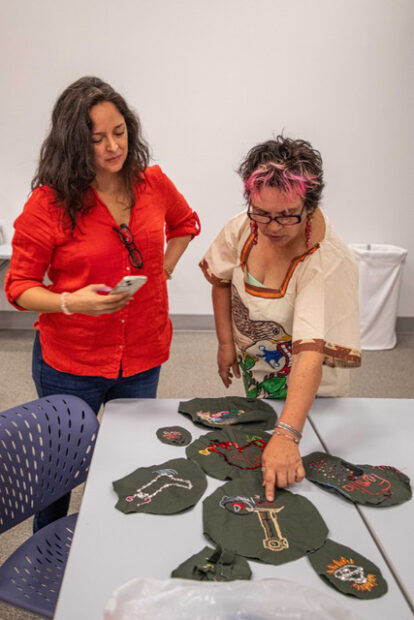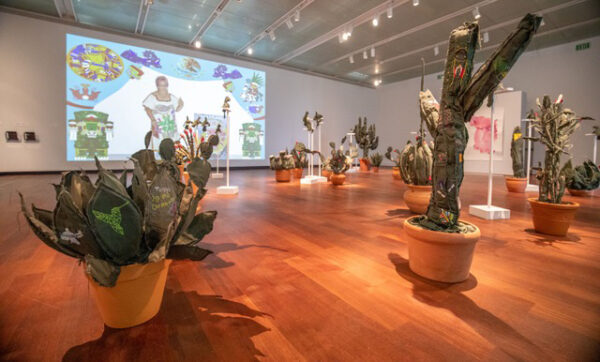
Installation view, “Margarita Cabrera: Blurring Borders,” McNay Art Museum, 2022. Courtesy of McNay Art Museum.
In Blurring Borders, on view at the McNay Art Museum in San Antonio, artist Margarita Cabrera brings together four bodies of work that deliver a chorus of stories from the border and beyond. Cabrera’s community-centered installations are layered with materials and meaning, starting with the show’s cushiony cacti, sewn out of U.S. Border Patrol uniforms. Chatty mechanical parrots (made from the same uniforms) are perched among the life-sized plant sculptures, as large-scale video monologues, projected across two walls, channel the energy of Aztec mythology. Not to mention the mysterious shapes floating around the gallery, which only those in the know can see.
“These works are about what is invisible and what’s in between,” says Edward Hayes, who co-curated the exhibition with René Paul Barilleux and Lauren Thompson of the McNay. “These are the stories of the undocumented — their struggles and their sacrifices.”
Cabrera has spent much of her career creating textile and soft sculptural works that examine the power dynamics playing out along the U.S.-Mexico border. Now nearing 50, she is increasingly involved in group collaborations that explore these same issues. The cacti, for instance, are from a series titled Space in Between, in which the artist organized community workshops for participants to embroider their personal stories of crossing the southern border onto recycled patrol agent uniforms. The uniforms’ dark green fabric has been shaped into plants that are native to the border region. Displayed in clay pots, these rough-hewn cacti — reminiscent of the border landscape itself — feature vibrant images of hope and resilience sewn onto their surfaces.
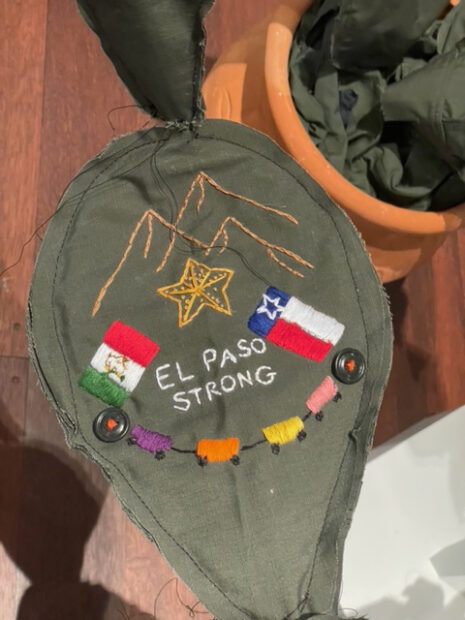
Installation view, “Margarita Cabrera: Blurring Borders,” McNay Art Museum, 2022. Photo by Barbara Purcell.
But among the embroidered flowers and hearts, darker themes emerge. “We Are Humans Not Animals” reads one nopal leaf, along with an image of children held in a cell. “El Paso Strong” appears on another, referencing the 2019 mass shooting at a Walmart in the city; a Texas and Mexico flag have been stitched on either side of a mountain backdrop, while bright-colored train cars connect the two. Despite difficult and often tragic stories told throughout these hand-sewn pieces, there is a prevailing sense of connection; an interwovenness that each thread comes to represent.
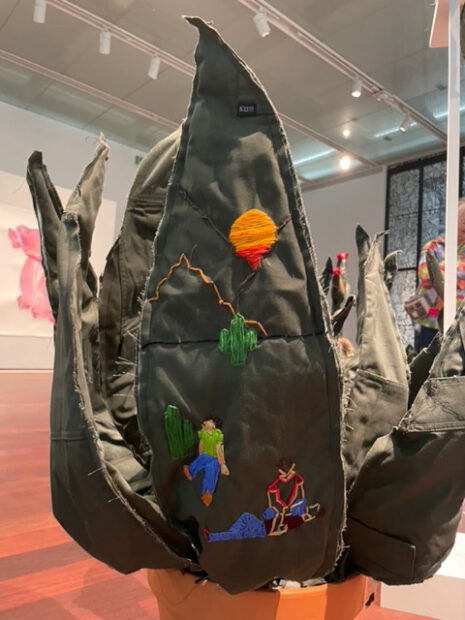
Installation view, “Margarita Cabrera: Blurring Borders,” McNay Art Museum, 2022. Photo by Barbara Purcell.
Cabrera was born in Monterrey, Mexico and moved to the United States with her family as a young girl. She has lived and worked in El Paso for much of her life, a city with an economic and cultural symbiosis that even a wall can’t quite separate (it was originally named, after all, El Paso del Norte — “the Pass to the North”). Cabrera further explores the strength of often invisible ties in the show’s video installation, TEQUITL, which began with an open call at the McNay earlier this summer, inviting San Antonio residents to come and share stories about their families and ancestry.
TEQUITL, which means “sacrifice” in the Aztec language Nahuatl, features five individuals recounting stories of loved ones and their long journeys made across lifetimes. Projected onto opposite walls of the gallery, their performances are silent, subtitled, but with a big-screen presence that pulls the viewer in. “It was then that my mother took off her beautiful wings, ripping them off her back, and placing them onto me,” recalls Sonia Rosario, about how a single decision — a sacrifice — made by her mother Gloria half a life ago determined the trajectory of her own life.
Each story is presented with such heart, it becomes clear that Cabrera’s own heart resides in their stories as well. Her social practice even extends to her solo works, as seen in her series, Pepita Para El Loro Para Que Hable, (“A nugget for the parrot so that it speaks or stays quiet”), where mechanical parrots — quirky and gadgety — remain perfectly still until spoken to. They are bilingual, I am told, and especially love the sound of clapping; the birds will chatter until their batteries run out.
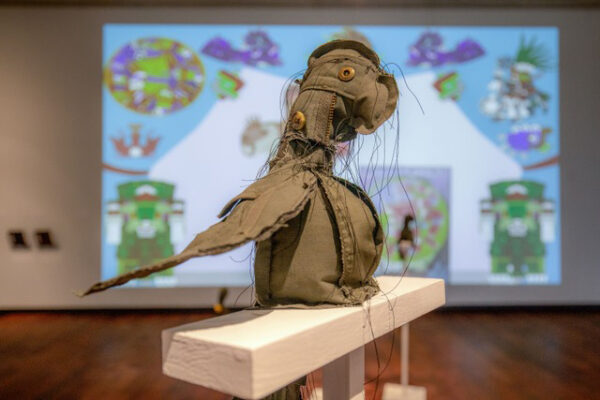
Margarita Cabrera, “Pepita Para El Loro Para Que Hable o Calle (A nugget for the parrot so that it speaks or stays quiet),” 2019, Border Patrol uniform fabric, thread, and audio device. © Margarita Cabrera.
“It belies the seriousness of what the parrots are about,” René Paul Barilleux tells me. “They engage you and you start to mine that information, if you take the time to do that.” The information, or pepita, one might mine is that these birds are a metaphor for assimilation — a fast-track for belonging by imitating others. The birds also call attention to the illegal exportation of Mexican Parrots to the U.S., which is apparently driving them into extinction. Ultimately, Cabrera’s poetic use of border patrol uniforms unveils a multipurpose metaphor: one that represents power, authority, and separation, but also transformation — when paired with a parrot (or a colorful embroidered image), the uniform becomes something else entirely.
There is one final body of work in Blurring Borders, and fittingly, it exists in a state of in between. Flujo de Extracción — “extraction flow” — requires an iPhone or tablet to view the pink, bodily forms quietly hovering (albeit in another dimension) in the gallery; a poignant reminder of things that remain unseen. The accompanying work on paper, a pink inkblot that bears a likeness to these mysterious forms, is the only physical proof of their existence. Cabrera has used cochineal gouache — a natural red dye derived from the dried bodies of the insects — to produce this abstract watercolor (and others like it in previous shows), which appears both beautiful and strange; human but foreign. Its pink bleeds the color of sacrifice.
“Essentially, there’s a whole story here of extracting natural resources,” says Hayes, pointing to all the nopal sculptures before us. “The cochineal will feed from this plant — and we will crush them to create this pigment.”
Margarita Cabrera: Blurring Borders is on view through February 5, 2023 at the McNay Art Museum in San Antonio.


